Bezalel Academy of Arts and Design
Bezalel Academy of Arts and Design (Hebrew: בצלאל, אקדמיה לאמנות ועיצוב) is an academic college of design and art located in Jerusalem, Israel. Established in 1906 by Jewish painter and sculptor Boris Schatz, Bezalel is Israel's oldest institution of higher education. It is named for the Biblical figure Bezalel, son of Uri (Hebrew: בְּצַלְאֵל בֶּן־אוּרִי), who was appointed by Moses to oversee the design and construction of the Tabernacle (Exodus 35:30). The art created by Bezalel's students and professors in the early 1900s is considered the springboard for Israeli visual arts in the 20th century.
בצלאל, אקדמיה לאמנות ועיצוב | |
 | |
Former names | Bezalel School |
|---|---|
| Type | Public Art school |
| Established | 1906 |
| Founder | Boris Schatz |
| President | Adi Stern |
| Students | 2,116 |
| Undergraduates | 1,911 |
| Postgraduates | 205 |
| Location | , |
| Campus | Urban |
| Website | bezalel.ac.il |
 | |
Bezalel is currently located at the Mount Scopus campus of Hebrew University of Jerusalem, with the exception of the Architecture department, which is housed in the historic Bezalel building in downtown Jerusalem. In 2009 it was announced that Bezalel will be relocated to a new campus in the Russian Compound, as part of a municipal plan to revive Jerusalem's downtown. The new Bezalel campus is planned by the Tokyo-based award-winning architectural firm SANAA.
History

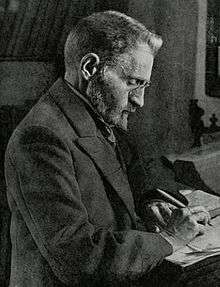

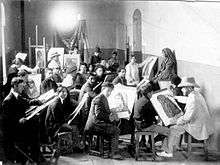
The Bezalel School of Arts and Crafts was founded in 1906 by Boris Schatz, who envisaged the creation of a national style of art blending classical Jewish/Middle Eastern and European traditions. The school opened in rented premises on Ethiopia Street. It moved to a complex of buildings constructed in the 1880s surrounded by a crenelated stone wall, owned by a wealthy Arab. In 1907, the property was purchased for Boris Schatz by the Jewish National Fund. Schatz lived on the campus with his wife and children.[1] Bezalel's first class consisted of 30 young art students from Europe who successfully passed the entrance exam. Eliezer Ben Yehuda was hired to teach Hebrew to the students, who hailed from various countries and had no common language.[2] His wife, Hemda Ben-Yehuda, worked as Boris Schatz's secretary.[3]
In addition to traditional sculpture and painting, the school offered workshops that produced decorative art objects in silver, leather, wood, brass, and fabric. Many of the craftsmen were Yemenite Jewish silversmiths who had a long tradition of working in precious metals, as silver- and goldsmithing, which had been traditional Jewish occupations in Yemen. Yemenite immigrants were also frequent subjects of Bezalel artists.
Many of the students went on to become well-known artists, among them Meir Gur Aryeh, Ze'ev Raban, Shmuel Ben David, Ya'ackov Ben-Dov, Zeev Ben-Zvi, Jacob Eisenberg, Jacob Pins, Jacob Steinhardt and Hermann Struck.[4]
In 1912, Bezalel had one female student, Marousia (Miriam) Nissenholtz, who used the pseudonym Chad Gadya.[5]
Bezalel closed in 1929 in the wake of financial difficulties. After Hitler's rise to power, Bezalel's board of directors asked Josef Budko, who had fled Germany in 1933, to reopen it and serve as its director.[6] The New Bezalel School of Arts and Crafts opened in 1935, attracting many teachers and students from Germany, many of them from the Bauhaus school shut down by the Nazis.[7] Budko recruited Jakob Steinhardt and Mordecai Ardon to teach at the school, and both succeeded him as directors.[6]
In 1958, the first year that the prize was awarded to an organization, Bezalel won the Israel Prize for painting and sculpture.[8]
In 1969, Bezalel became a state-supported institution. In 1975 it was recognized by the Council for Higher Education in Israel as an institute of higher education.[9] It completed its relocation to Mount Scopus in 1990.
Ceramics: the "Bezalel tiles"
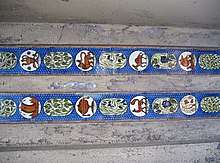
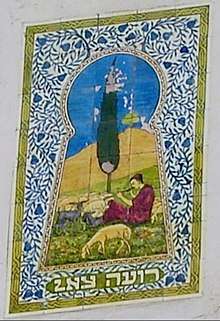
Decorative ceramic tiles with figurative motives with both biblical and Zionist scenes were created in the 1920s at the Bezalel School, with some surviving until today. In Tel Aviv some of the best known examples are the following:
- Lederberg House (1925) at the corner of Allenby Street and Rothschild Boulevard, ceramic tiles designed by Ze'ev Raban
- Moshav Zkenim Synagogue (also spelled Zekenim), 89 Allenby Street
- Municipal School, 37 Ahad Ha’Am Street (built 1924)
- Bialik House, or Beit Bialik
There are Bezalel-made ceramic street signs surviving in Jerusalem.
Bezalel pavilion
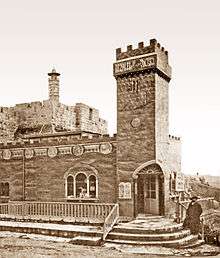
Bezalel pavilion was a tin-plated wooden structure with a crenelated roof and tower built outside Jaffa Gate in 1912. It was a shop and showroom for Bezalel souvenirs. The pavilion was demolished by the British authorities six years later.
Bezalel style
Bezalel developed a distinctive style of art, known as the Bezalel school, which portrayed Biblical and Zionist subjects in a style influenced by the European jugendstil (art nouveau) and traditional Persian and Syrian art. The artists blended "varied strands of surroundings, tradition and innovation," in paintings and craft objects that invokes "biblical themes, Islamic design and European traditions," in their effort to "carve out a distinctive style of Jewish art" for the new nation they intended to build in the ancient Jewish homeland.[10]
Today
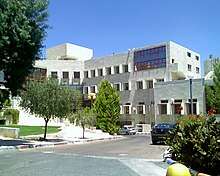
In 2006, the Bezalel Academy of Art and Design celebrated its 100th anniversary. Today, it is located on Mount Scopus in Jerusalem and has 1,500 students. Faculties include Fine Arts, Architecture, Ceramic Design, Industrial Design, Jewelry, Photography, Visual Communication, Animation, Film, and Art History & Theory. The architecture campus is in downtown Jerusalem, in the historic Bezalel building. Bezalel offers Bachelor of Fine Arts (B.F.A.), Bachelor of Architecture (B.Arch.), Bachelor of Design (B.Des.) degrees, a Master of Fine Arts in conjunction with Hebrew University, two different Master of Design (M.des) degrees and Theory and Policy of art (M.A.)
The academy has plans to move back to the city center.[11]
In 2011, the Bezalel student show at the Milan Furniture Fair was described as a "lively runner-up" for the best exhibit.[12]
Notable alumni
- Baruch Agadati (1895–1976), Russian-Palestinian-Israeli classical ballet dancer, choreographer, painter, film producer and director
- Yaacov Agam (born 1928), sculptor and experimental artist
- Gideon Amichay (born 1963), communication artist, cartoonist, writer
- Ron Arad (born 1951), industrial designer
- Avigdor Arikha (1929–2010), painter
- Netiva Ben-Yehuda (1928–2011), author, editor, Palmach commander
- Moti Bodek (born 1961), architect, lecturer
- Elinor Carucci (born 1971), photographer
- Yitzhak Danziger (1916–1977), sculptor
- Uri Gershuni (born 1970), photographer
- Yoni Goodman (born 1976), animator and illustrator
- Nachum Gutman (1898–1980), painter, sculptor, author
- Vania Heymann (born 1986), film director
- Nir Hod (born 1970), artist
- Anat Hoffman (born 1954), executive director of Israel Religious Action Center and director and founding member of Women of the Wall
- Itshak Holtz (born 1925), painter
- Gurwin Kopel (1923–1990), artist
- Yaron London (born 1940), media personality, journalist, actor, songwriter
- Joshua Meyer (born 1974), painter
- Roy Nachum (born 1979), contemporary artist
- Itay Noy, watchmaker
- Ran Poliakine (born 1967), serial entrepreneur
- Zvi Raphaeli (1924-2005), painter and Rabbi
- Ophrah Shemesh (born 1952), painter
- Avigdor Stematsky (1908–1989), painter
- Yehezkel Streichman (1906–1993), painter
- Lidia Zavadsky (born 1937), sculptor
Notable faculty
- Samuel Hirszenberg (1865–1908), painter
- Yaacov Kaufman (born 1945), industrial designer
- Aaron Marcus, (born 1943), graphic designer and computer artist, Visiting Faculty, 1977–78
- Abraham Neumann (1873–1942), painter
- Abel Pann (1883–1963), painter
- Ze'ev Raban (1890–1970), painter, decorative artist, and industrial designer
- Siona Shimshi (born 1939), painter, sculptor, ceramist, and textile designer
- Sari Srulovitch (born 1964), artist and silversmith
- Joshua Neustein (born 1940), contemporary visual artist
See also
- Jewish ceremonial art
- List of Israel Prize recipients
- List of Israeli visual artists
- List of universities and colleges in Israel
References
- "The Bezalel artistic legacy flourishes in Jerusalem". The Times of Israel.
- "Albert Rubin catalogue" (PDF). mmuseumeinharod.org.il. Archived from the original (PDF) on 2014-08-18. Retrieved 2014-11-25.
- "The long-lost daughter of the father of Israeli art". Haaretz.com. 12 January 2013.
- Ze'ev Raban, A Hebrew Symbolist, by Batsheva Goldman Ida, Tel Aviv Museum of Art, 2001
- "I lived life to the fullest". haaretz.com.
- "When Budko met Bialik".
- "Israeli Art On Its Way to Somewhere Else". azure.org.il.
- "Israel Prize recipients in 1958 (in Hebrew)". Israel Prize Official Site. Archived from the original on February 8, 2012.
- המועצה להשכלה גבוהה - מאגר מוסדות [Council for Higher Education Registry of Institutes]. che.org.il (in Hebrew). Archived from the original on February 7, 2009. Retrieved August 4, 2010.
- Rothstein, Edward (June 10, 2009). "MUSEUM REVIEW - DERFNER JUDAICA MUSEUM, Jewish Art, the Hudson and Bingo in the Bronx". The New York Times.
- Zohar, Gil (November 2, 2006). "Artful move". Jerusalem Post. Archived from the original on May 27, 2012. Retrieved September 19, 2011.
- Rawsthorn, Alice (18 April 2011). "Milan's Furniture Whirlwind" – via www.nytimes.com.
Further reading
- Gil Goldfine, "Zeev Raban and the Bezalel style," Jerusalem Post, 12-14-2001
- "Dalia Manor, Biblical Zionism in Bezalel Art," Israel Studies 6.1 (2001) 55-75".
- The "Hebrew Style" of Bezalel, 1906–1929, Nurit Shilo Cohen, The Journal of Decorative and Propaganda Arts, Vol. 20. (1994), pp. 140–163
- Manor, Dalia, Art in Zion: The Genesis of National Art in Jewish Palestine, published by Routledge Curzon (2005)
- "Crafting a Jewish Style: The Art of the Bezalel Academy, 1906–1996", 2000-08-26 until 2000-10-22, Montgomery Museum of Fine Arts